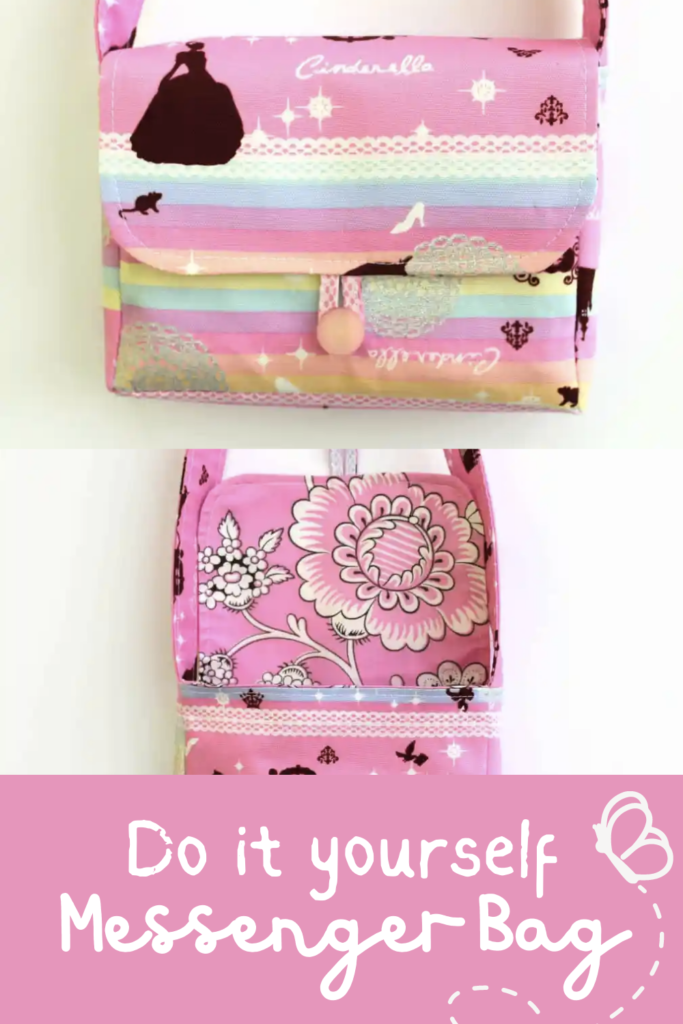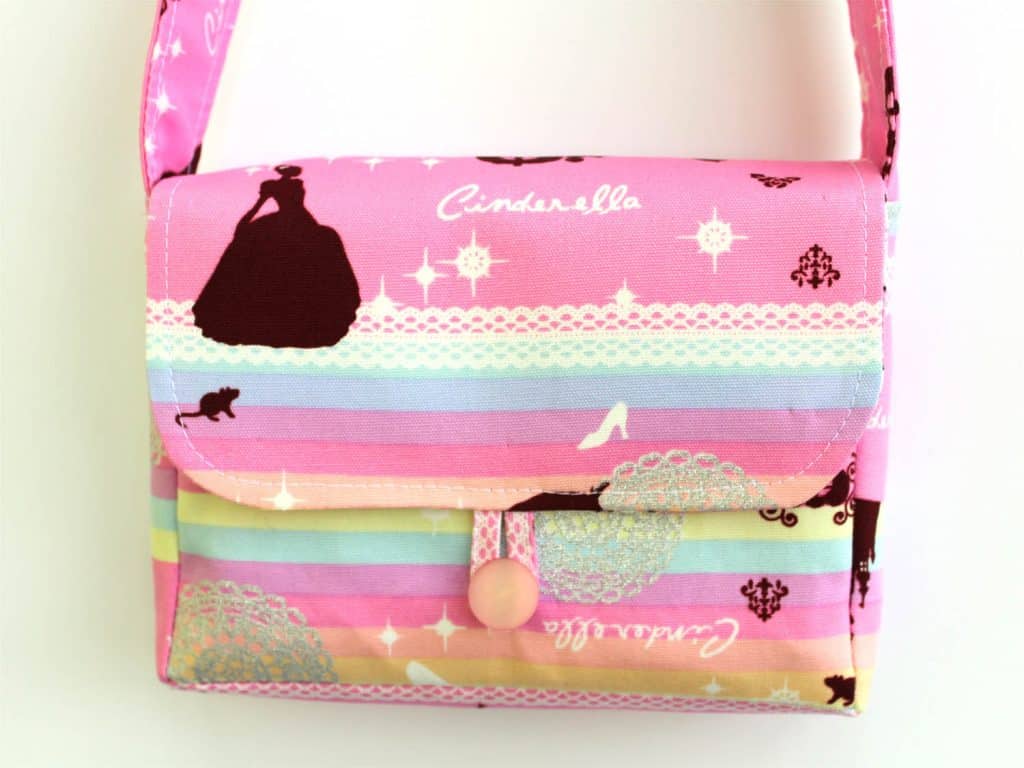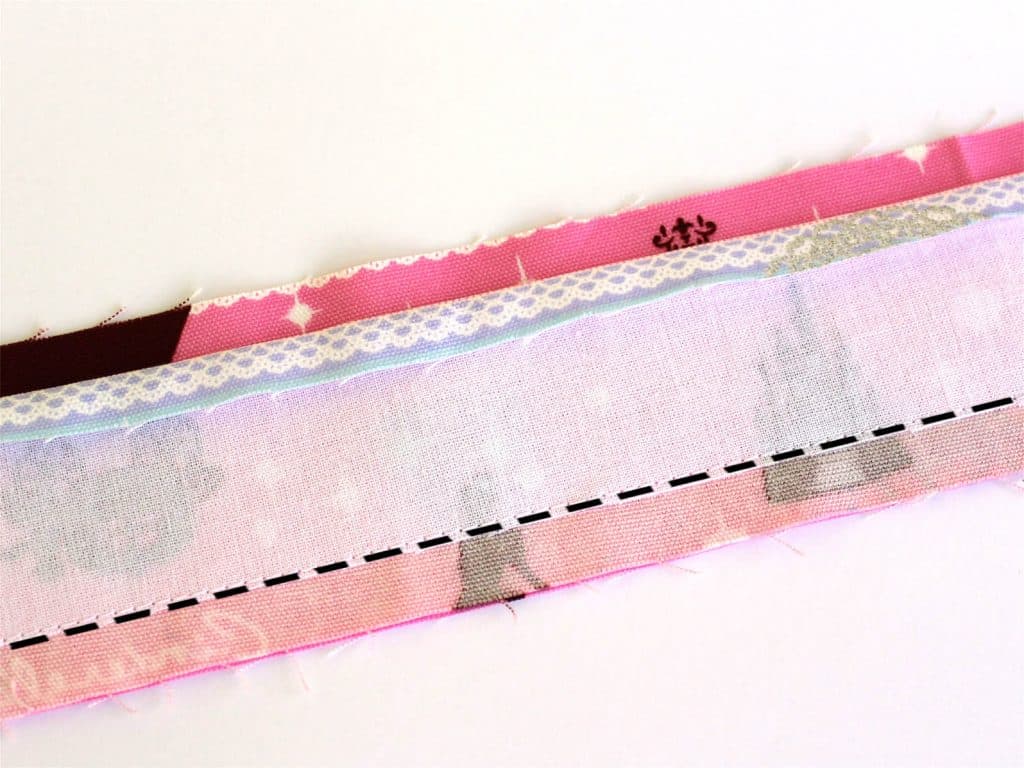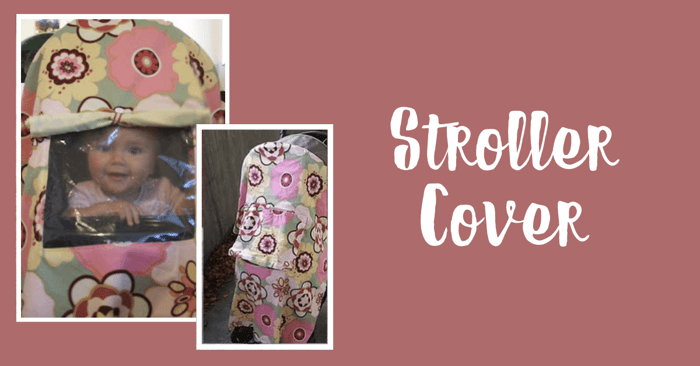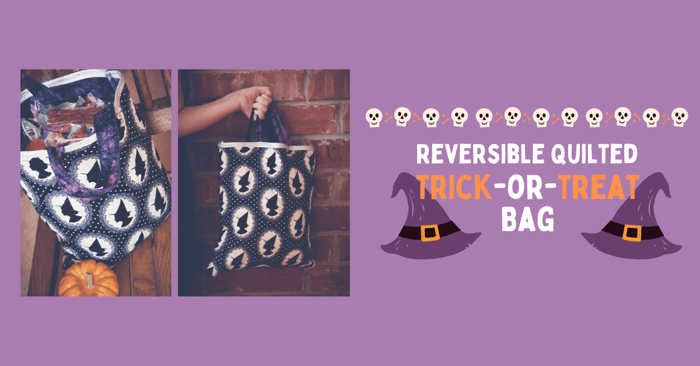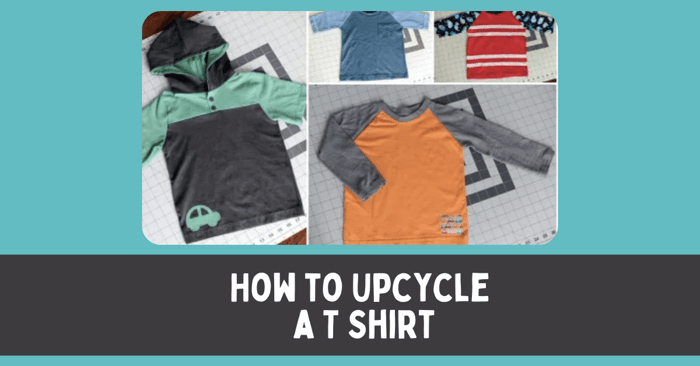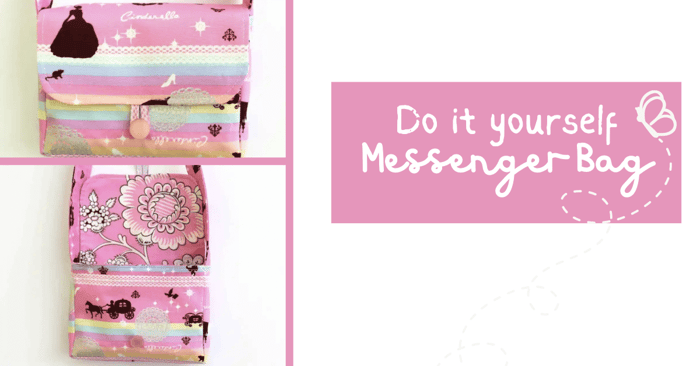
DIY Messenger Bag | Free Bag Tutorial
I don’t know about you, but every child I know wants to carry around their treasures. This DIY Messenger Bag tutorial will teach you how to make a child’s sized messenger bag. This bag would be the perfect birthday gift or get a jump on Christmas and start making them now!
DIY Messenger Bag | Make this Messenger Bag
DIY Messenger Bag Supplies Needed:
- Exterior Fabric – 1/3 yard of canvas preferably, quilting cotton or any medium to heavyweight fabric that can be ironed.
- Interfacing – 1/4 yard of Pellon Shapeflex 101 or any woven medium weight iron-on interfacing.
- Lining Fabric – Fat Quarter of quilting cotton or lightweight fabric that can be ironed.
- Button – One button with a shank, 5/8″ – 1.”
- Other Supplies – Sewing machine, scissors, iron, ironing board, ruler, pins and matching thread.
Messenger Bag Tutorial & Cutting Instructions:
You'll need a couple of different type of fabrics for the outside and lining piece. Make some color choices that match well for your new bag.
Main Fabric for Outside of the Bag / Strap Fabric–
- Front (Cut 1) 6″ tall x 8″ wide
- Sides (Cut 2) 6″ tall x 2.5″ wide
- Bottom (Cut 1) 2.5″ tall x 8″ wide
- Back/Flap (Cut 1) 11″ tall x 8″ wide
- Strap (Cut 2) 2.5″ wide x 32″ long *See note below under tutorial instructions about length.
- Button Closure (Cut 1) 1″ wide x 4″ long
Lining Fabric – Cut the Front, Sides, Bottom and Back/Flap using the same dimensions as the Exterior Fabric. You do not need to cut a strap or button closure.
Interfacing –
- (Cut 1) 5″ x 7″
- (Cut 2) 1.5″ x 5″
- (Cut 1) 1.5″ x 7″
- (Cut 1) 7″ x 10″
- (Cut 1) 1.5″ x 32″ for the strap, or cut several strips that are 1.5″ wide and combined end up to 32″ in length.
Messenger Bag Sewing Tutorial
Step 1: This tutorial uses a 1/2″ seam allowance throughout.
*The 32″ length strap is the perfect length for my 4 year old daughter. She wears the bag cross-body style and it hits her at the hip. If you have an older child that you are making the bag for then you may want to use a tape measure and measure from hip to hip going around the shoulder (cross-body) to see if you need to lengthen or shorten the strap.
Let’s get started!
Step 2:The first step is to apply the interfacing to the exterior fabric using the manufacturer’s instructions. Center the interfacing on the wrong side of the exterior fabric, there should be 1/2″ of space around each piece of interfacing. Fuse the interfacing to the front, two sides, bottom, flap/back and one of the strap pieces.
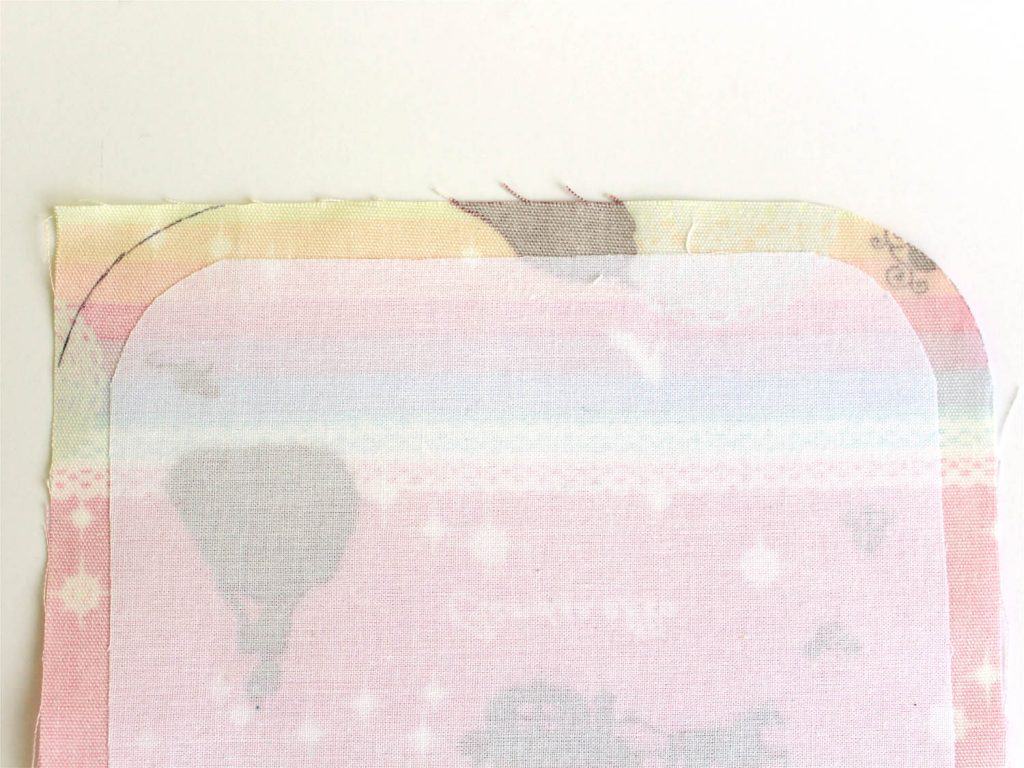
Step 3: On the flap/back piece of fabric determine which end will be the flap, this piece of fabric will be the back of the messenger bag and then fold over to the front to become the front flap. Make sure the print/pattern orientation is facing in the correct direction. Once you have determined the flap end using a circular template (I used a mug I had sitting on my desk.)
Step 4:Trace the curve to create rounded corners. It is up to you how rounded you want the edges, for a larger curve you can use a plate or larger cup. Once you are happy with the curve, carefully trim the fabric following the line. Trim the interfacing before you fuse it down to follow the shape of the curve.
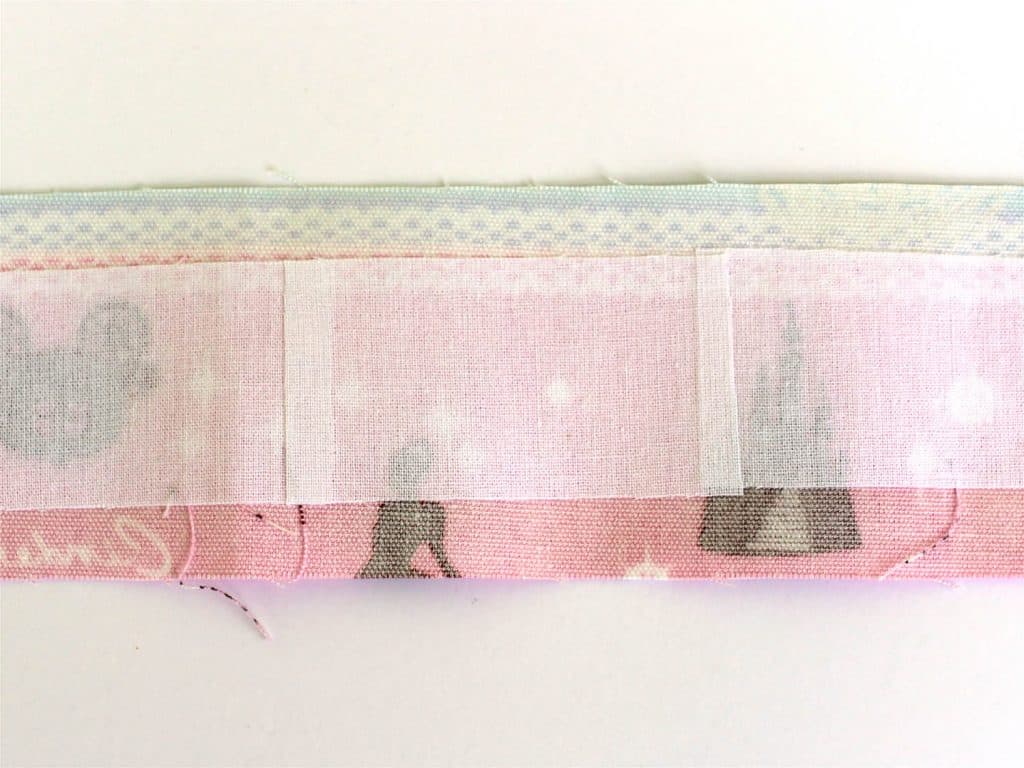
Step 5: Sometimes you don’t have a piece of interfacing long enough for the strap. It is ok to cut several pieces of interfacing for the strap. Slightly overlap the interfacing when you fuse it down. In the photo above you can see that this is what I did, I used three pieces and overlapped them about 1/4.”
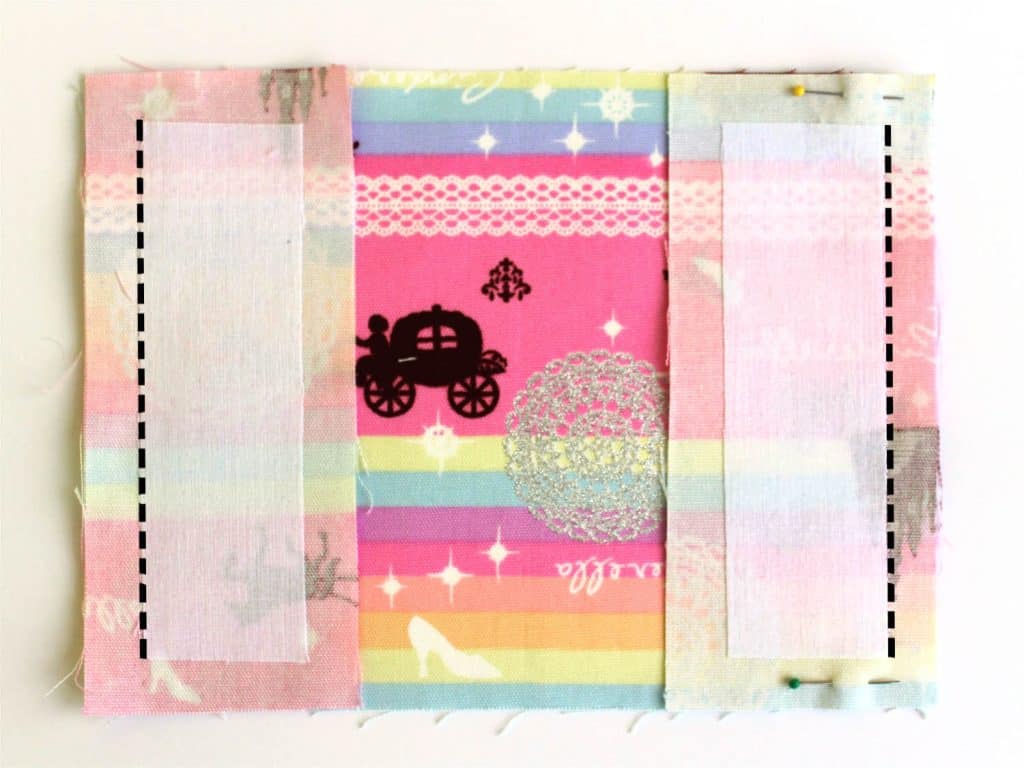
Step 6: Time to start sewing the DIY messenger bag! Using the exterior front piece and the two side pieces, line up the two sides on the ends of the front piece. Pin in place, right sides together. Stitch using a 2.5 stitch length starting and stopping 1/2″ from the top and bottom.
Step 7: You will be stitching right alongside the interfacing and starting and stopping when the interfacing stops. Use the interfacing as your stitching guide, back-stitching at both ends.
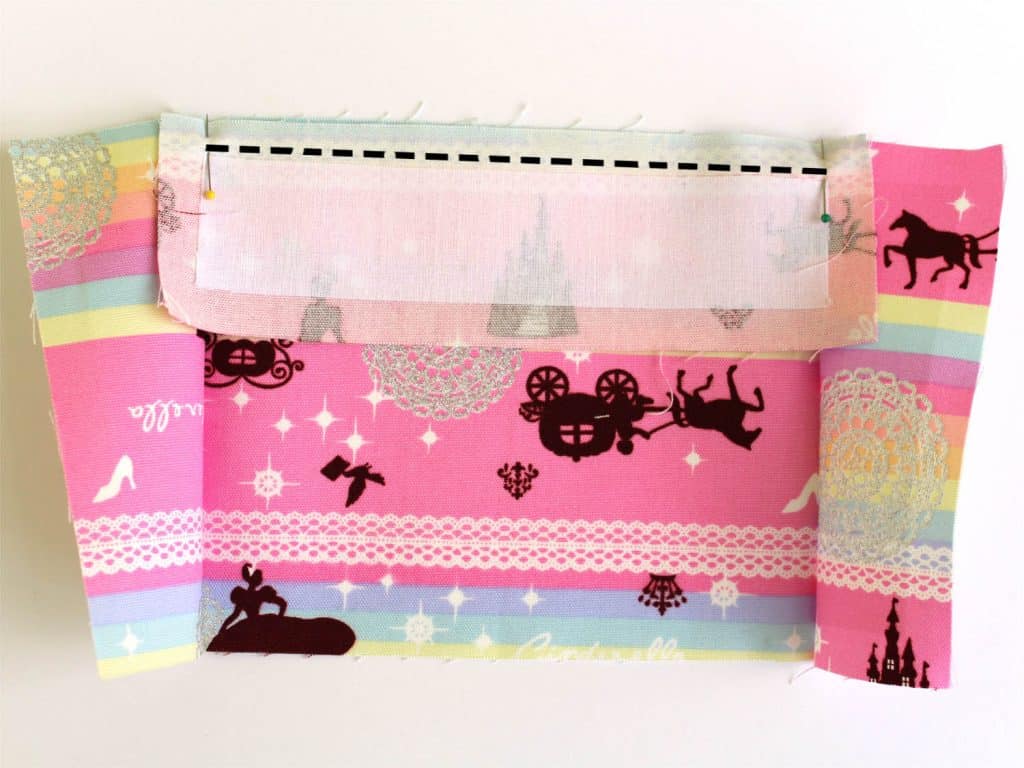
Step 8: Now that the two sides are sewn on, fold them out. Take the bottom piece, line it up, right sides together with the bottom of the front piece. The folded out side pieces will create a “bump” and this bump will be your starting and stopping points.
Put a pin right where the bump ends, which should be 1/2″ in from the edge of the bottom piece and right where the interfacing starts. Sew this seam right along the interfacing, back-stitching at both ends. You do not want to stitch onto the bump or the side pieces.
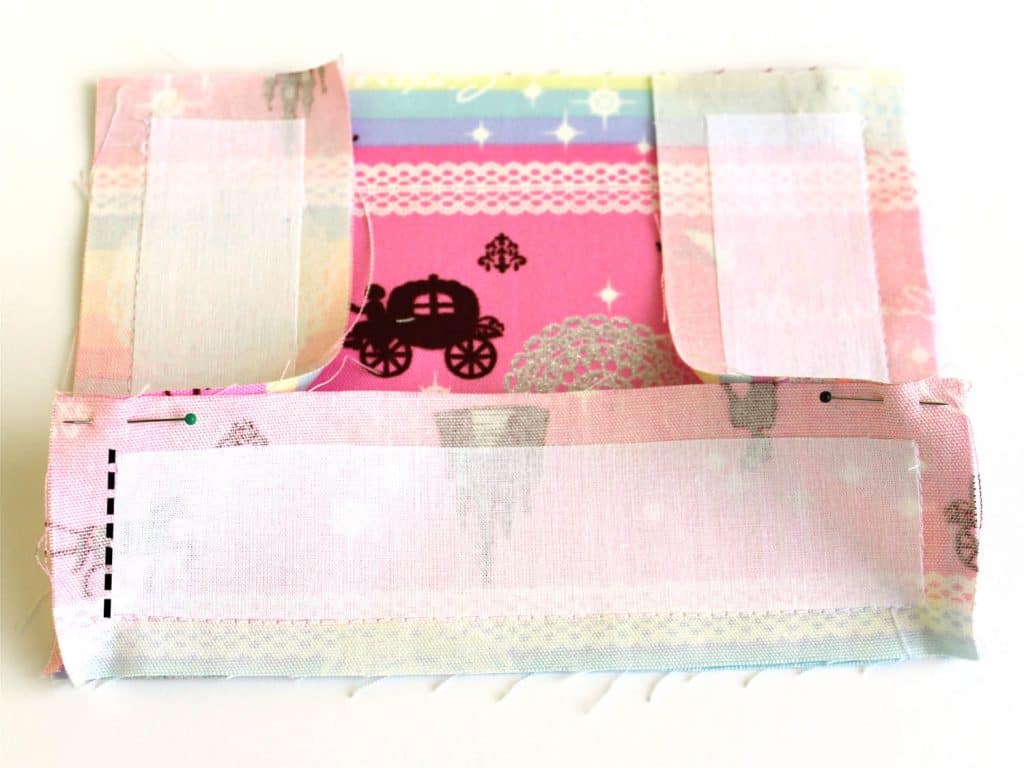
Step 9: You now have three separate pieces sewn onto the front piece of your diy messenger bag. We need to connect the three pieces together. Take the short end of the bottom piece and line it up with the short end of the side piece. Pin and stitch right along the interfacing, stopping and starting 1/2″ away from the ends.
You will have to fold/manipulate the fabric “body” out of the way. Repeat this for the the other side. Basically you are making a 3D box out of fabric.
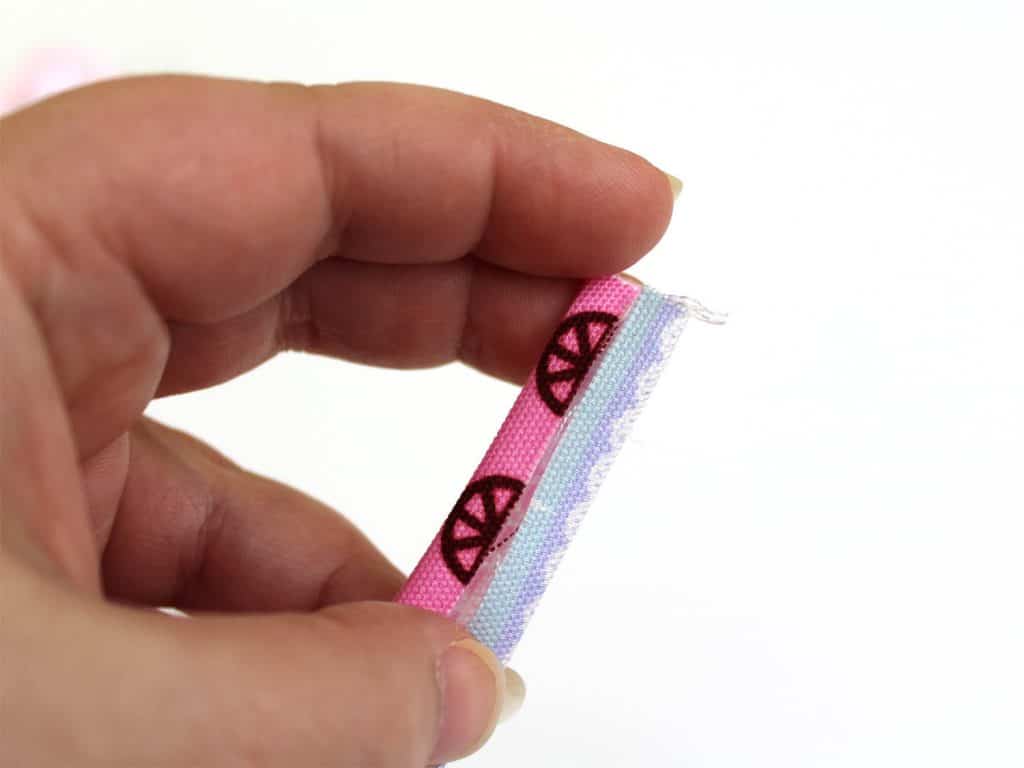
Step 10: Take the button closure piece of fabric, fold it in half, wrong sides together with long edges meet. Iron. Open it up and fold the raw edges toward the center-ironed line. Press again. You should have a 1/4″ x 4″ piece of fabric. Sew the folded edge closed as close to the edge as you can.
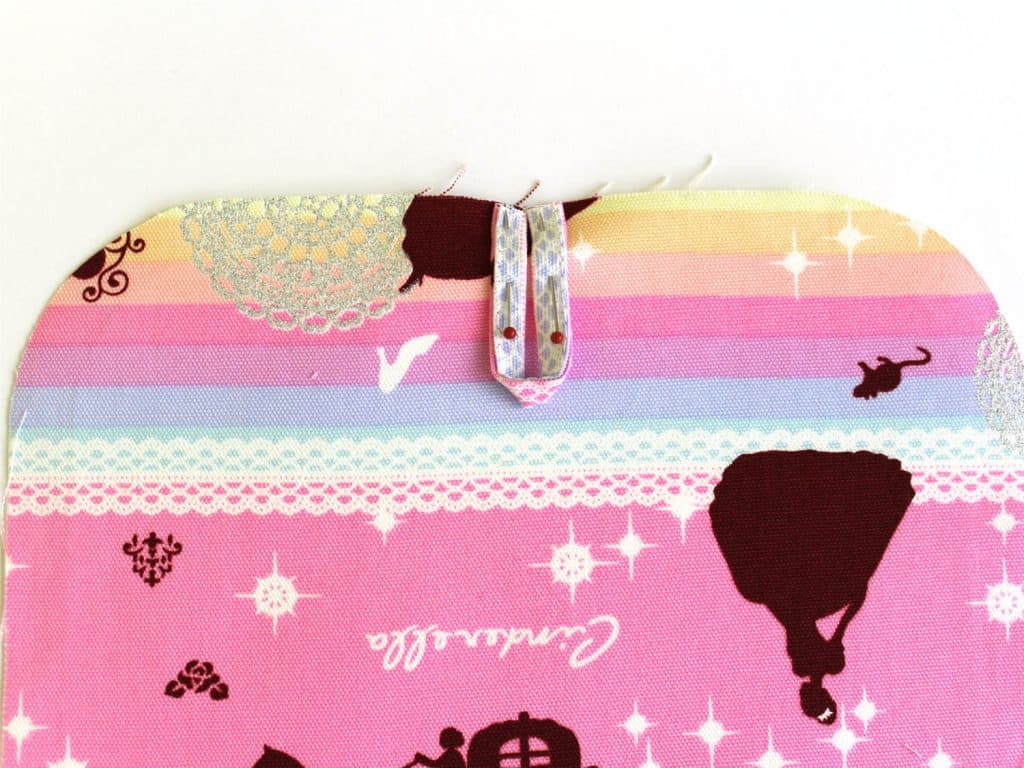
Step 11: If you have a 5/8″ button, you will need to trim the button closure piece to 3 1/4″ long. Have a larger button? You will need to determine how long to make your button closure piece. Fold it in half and see if your button will fit through the loop. Once you have determined the button closure length. Mark the center of the back/flap piece, (you will be putting the button closure on the rounded side.) Pin both ends of the button closure to the center like the photo above. Baste the button closure at a 3/8″ seam allowance and remove pins.
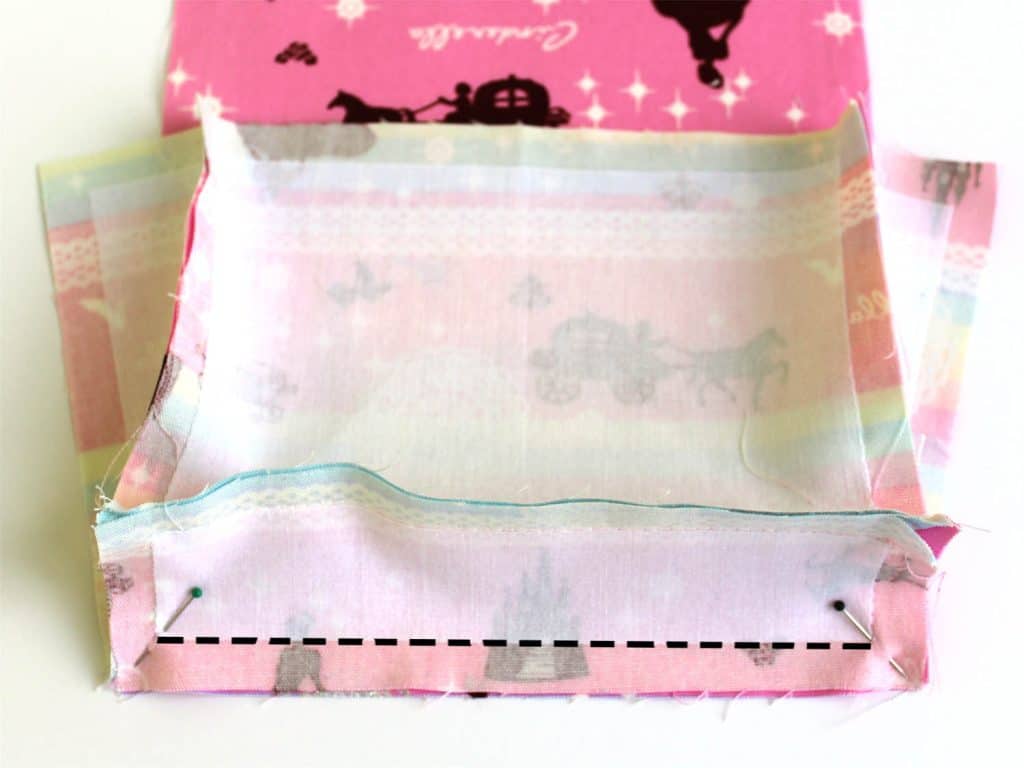
Step 12:Take the front piece with the sides sewn on and line up the bottom piece with the bottom of the back/flap piece. You will be sewing this on the square side and not the rounded side. Push the side pieces out of the way. Pin right sides together at the “bumps” and sew along side the interfacing, stopping and starting 1/2″ away from the ends. Back-stitching at both ends.
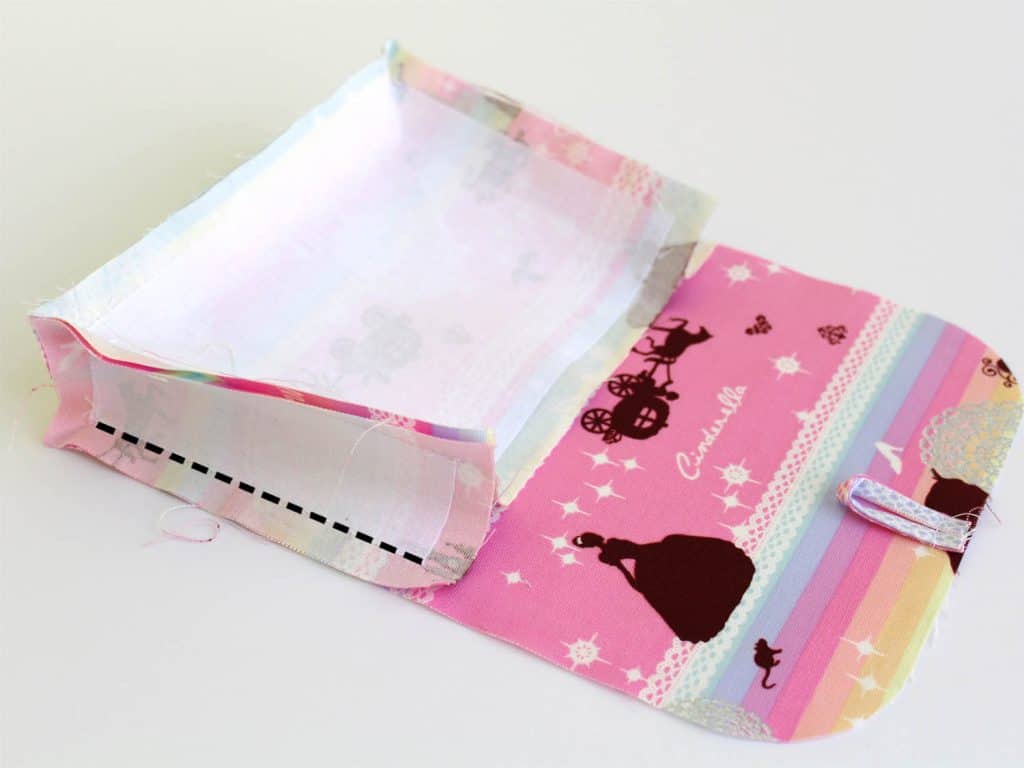
Step 13: Now it’s time to finish the “box.” Move the two side pieces into place and pin, right sides together. Sew the seam next to the interfacing, stopping and starting 1/2″ away from the ends. Back-stitching at both ends. Repeat for the other side. Hooray! You have a box. Your bag should look like the photo above at.
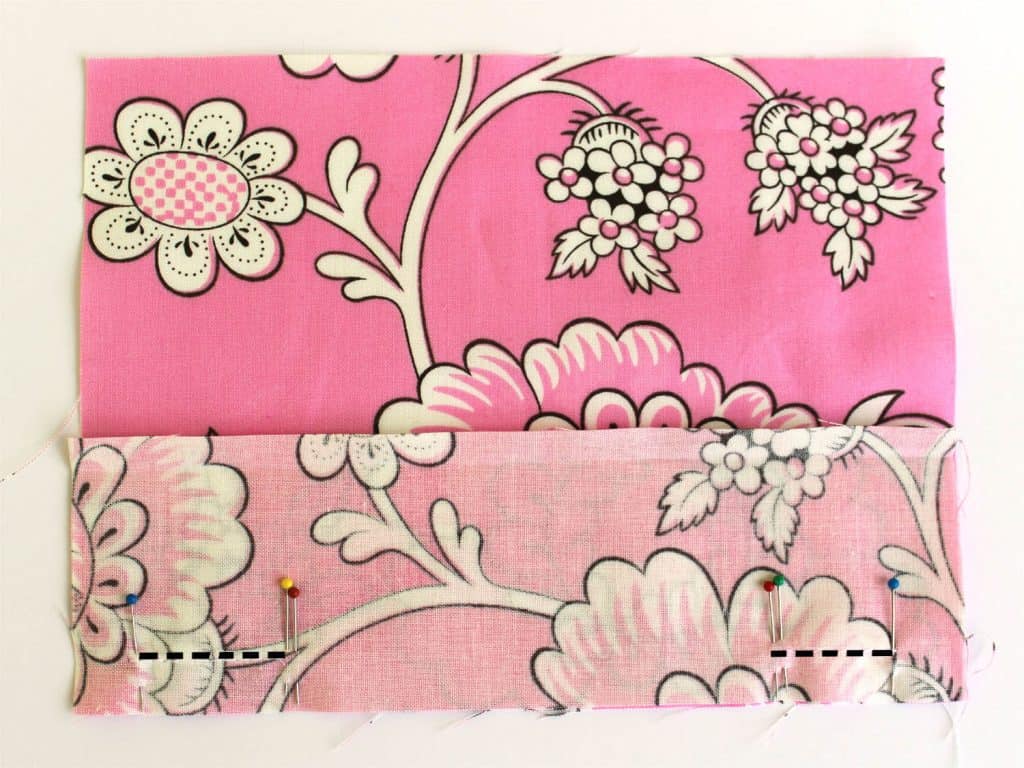
Step 14: Now it’s time to work on the lining of the diy messenger bag, which will be constructed exactly the same as the exterior except for one step. Grab the front piece of lining and the bottom piece of lining. Pin in place just like you did before. Place a set of double pins toward the center about 1.5″ away from the side edge. Repeat for the other side. Your lining should look like the photo above. Stitch 1/2″ in from the edge to the double pins. Back-stitching at both ends. Repeat for the other side. You are creating the hole in which you will turn your bag right side out later on. The opening will be roughly 4″ wide.
Step 15: Continue to assemble your lining in the same manner in which the exterior was constructed, right sides together. Sew on the sides, then connect the sides to the bottom. Finally connect the front piece with three sides to the back/flap piece. On all of these seams start and stop 1/2″ away from the edge, back-stitching at each end.
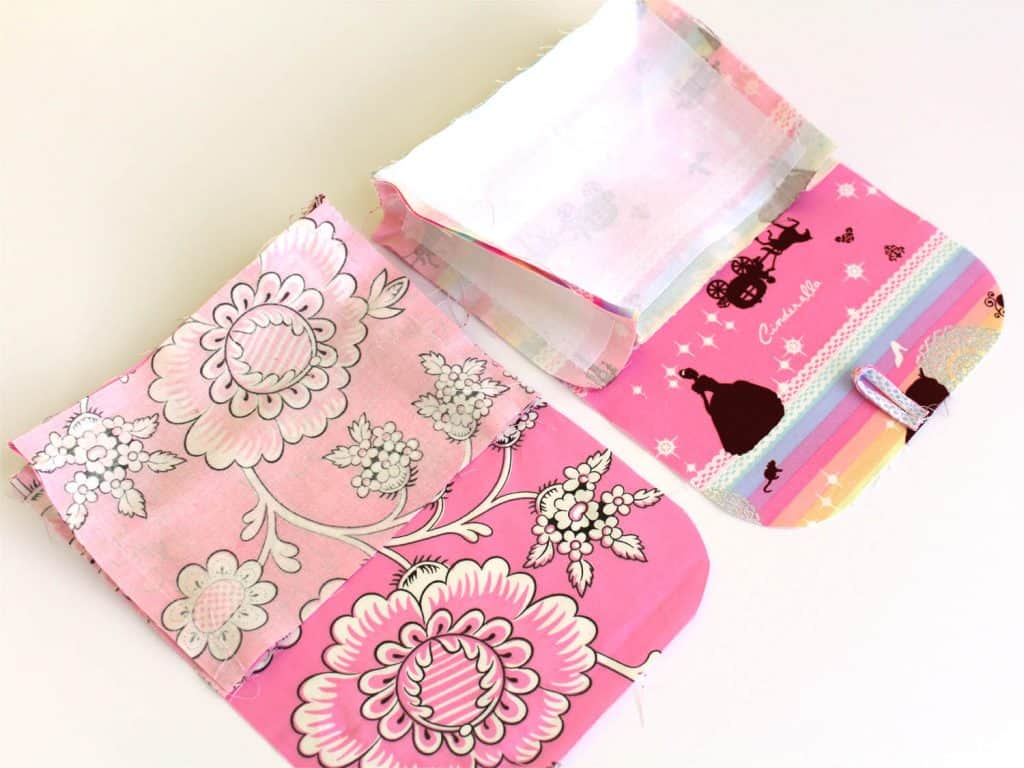
Step 16: You should now have two sewn “messenger bags.” The exterior and the lining, they should both look like the photo above.
Make the Messenger Bag Strap
Step 17: Time to sew the strap! Take the two strap pieces, line them up right sides together and sew along the long edge of the interfacing using a 1/2″ seam. Once sewn, fold over the raw edge of the fabric right along the interfacing and press. The strap should look like the photo above.
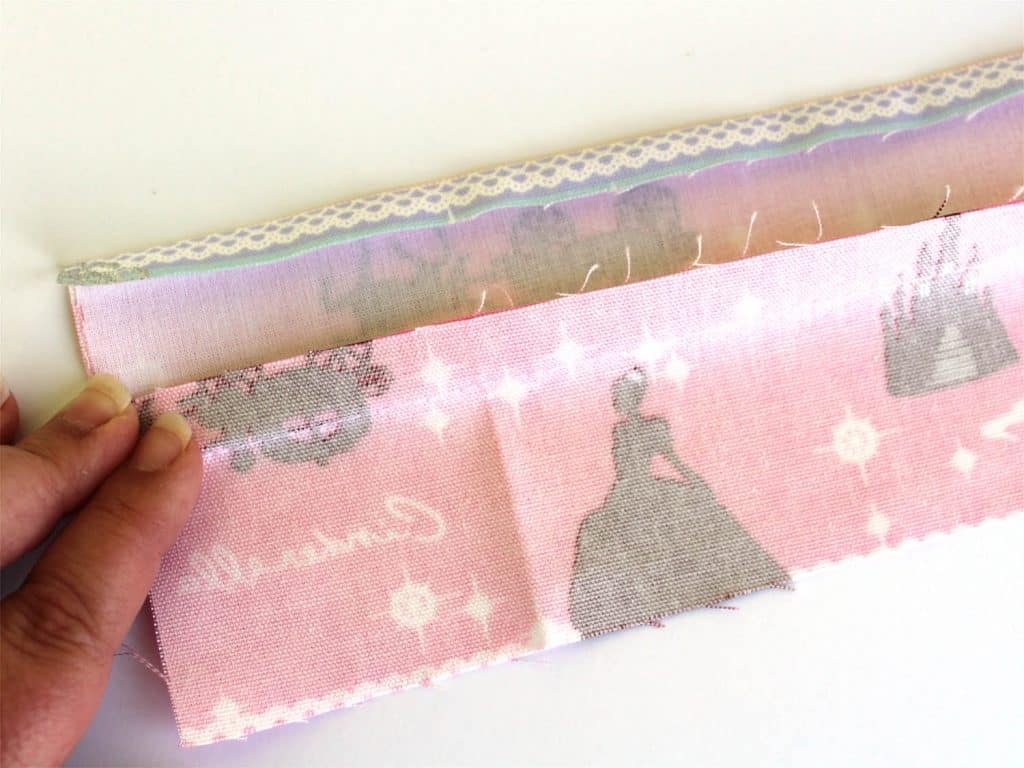
Step 18: Open up the strap and press the 1/2″ seam toward the other pressed in edge. Fold the strap closed and press the seam flat.
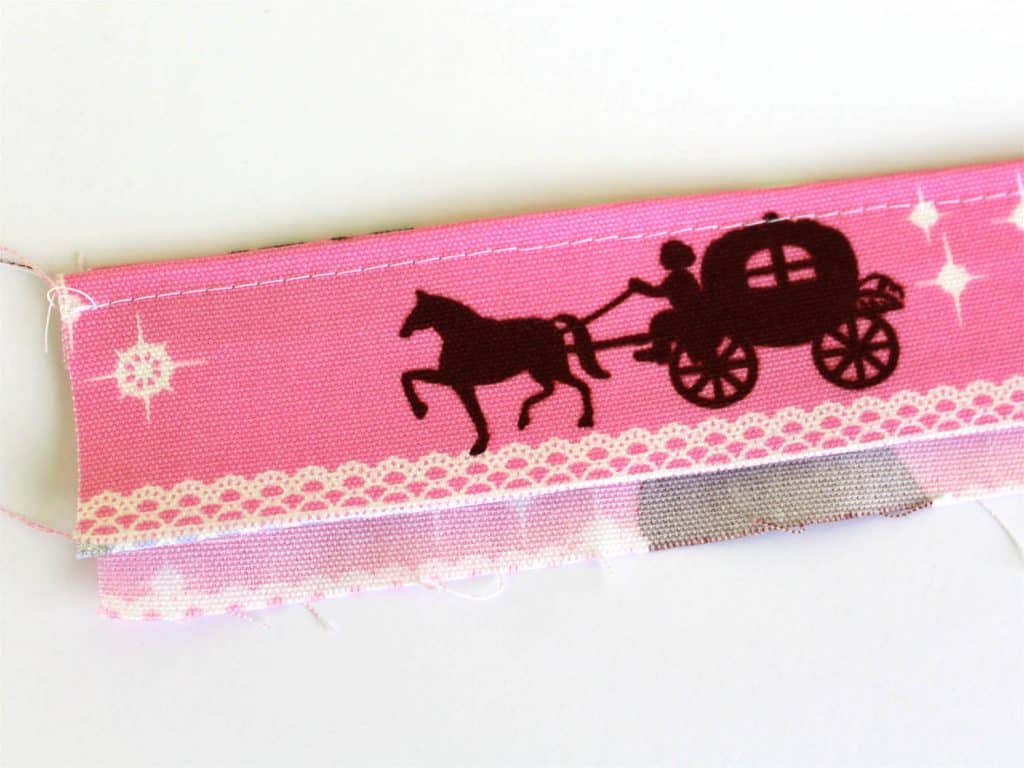
Step 19: Top stitch using a 3.0 seam length, 1/4″ away from the pressed/sewn seam.
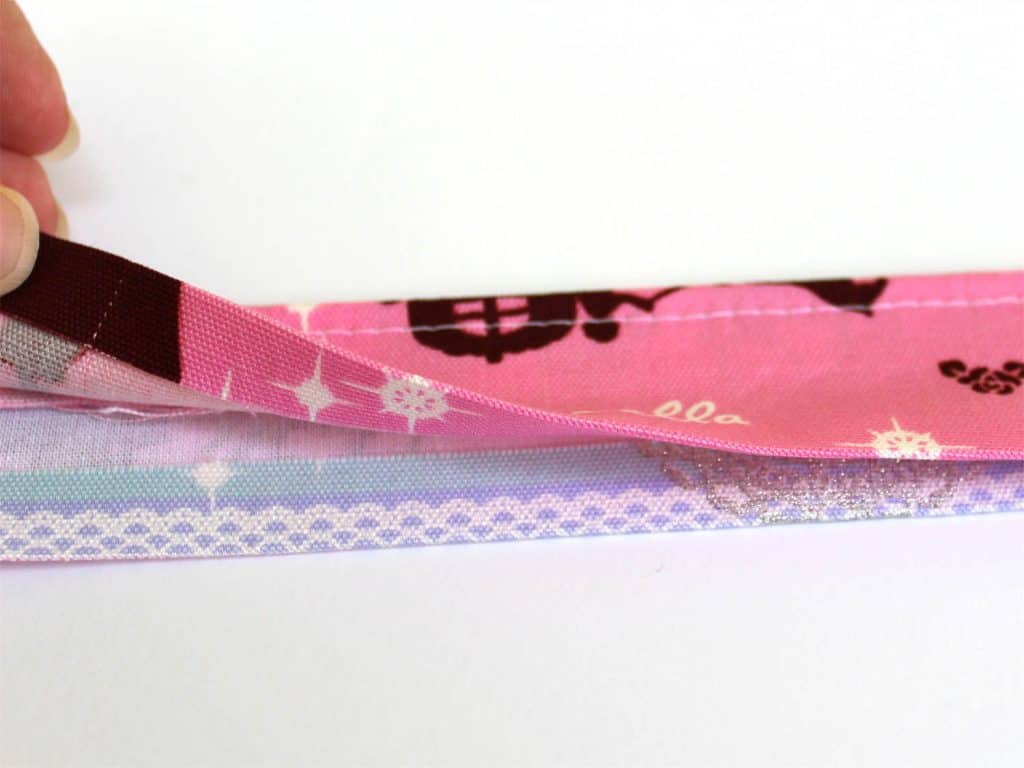
Step 20: Take the raw edge that isn’t turned under and fold it inside the strap so that it is the same width as the other side that is pressed under. Iron well and then sew a top-stitched 1/4″ seam to close and encase the raw edges. The strap is now finished.
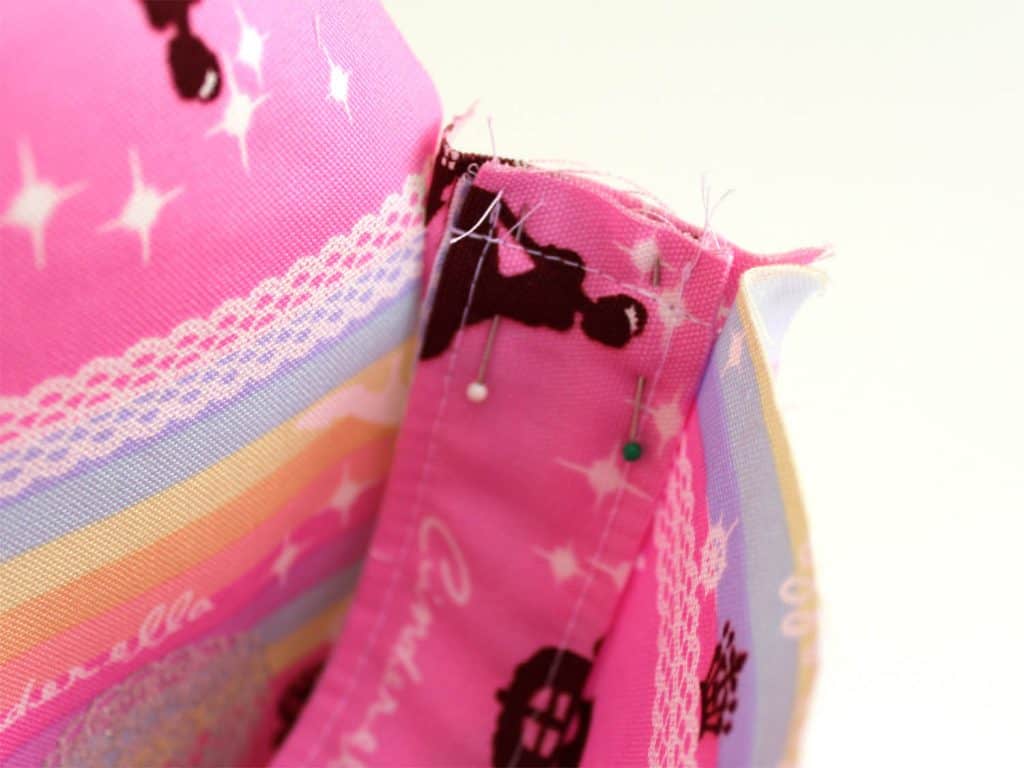
Step 21: Right sides together, pin one edge of the strap onto the side of the exterior bag. You will be working in the inside of the bag. Baste with a 3/8″ seam.
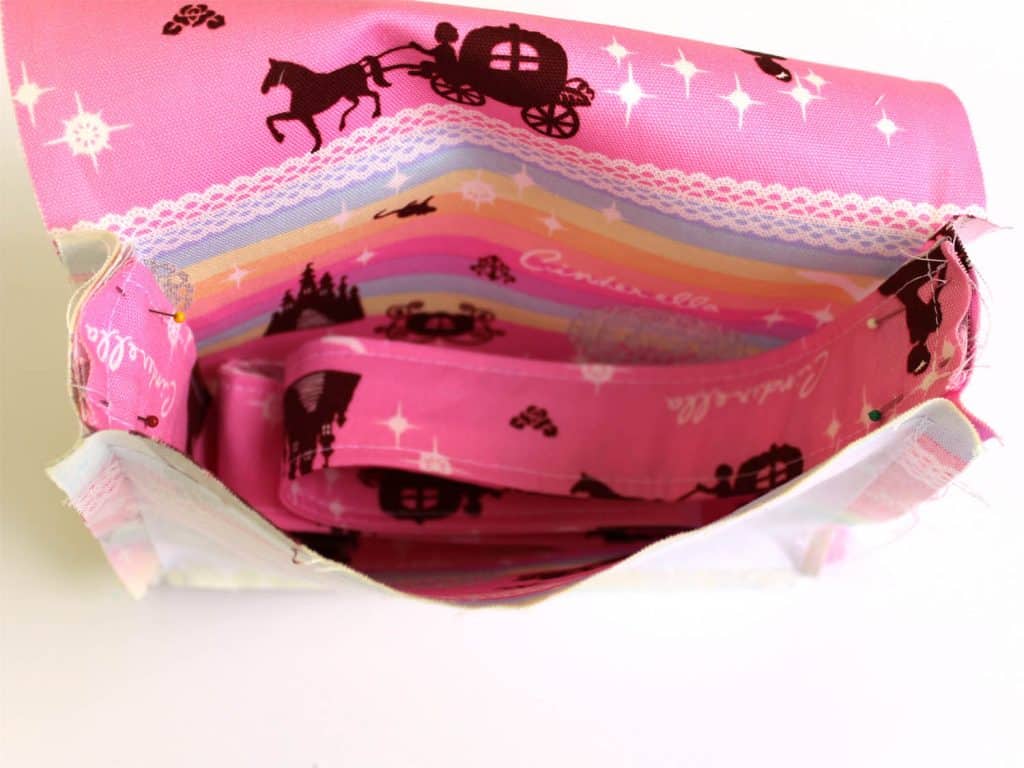
Step 22: Taking care not to twist the strap, pin the other end of the strap, right sides together on the side of the bag. Baste with a 3/8″ seam. The photo above shows that the strap is carefully folded inside the bag and not twisted.
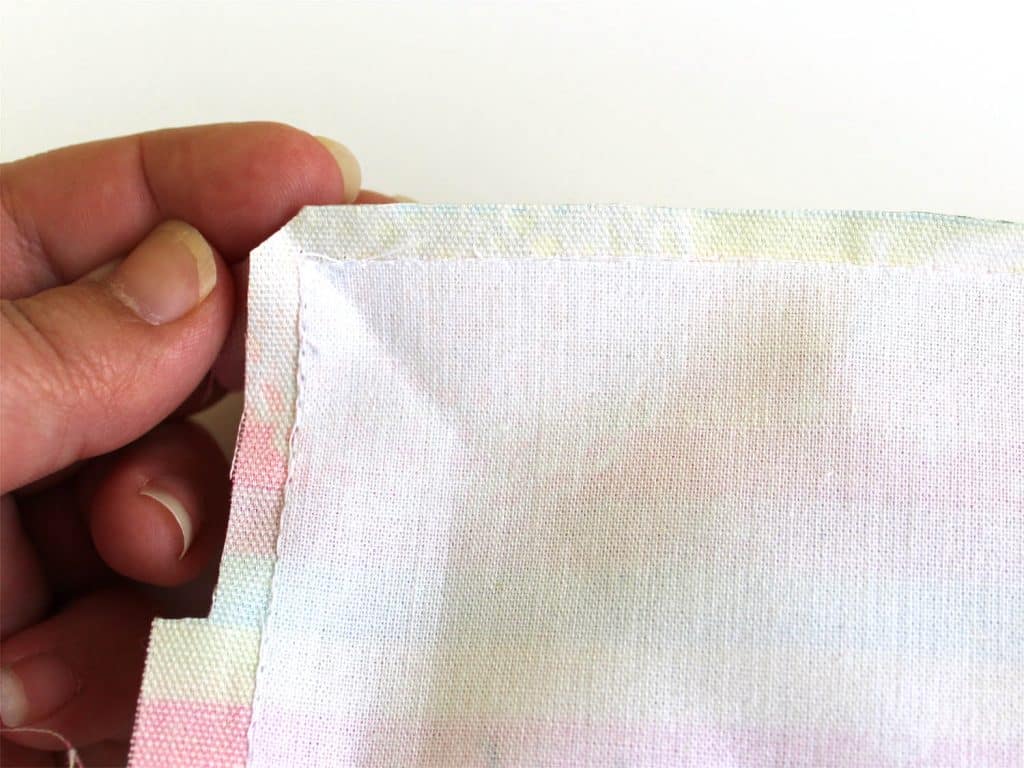
Step 23: We need to trim those seams to reduce bulk. Trim all the exterior and lining body seams to 1/4″. Clip the bottom corners like the photo above. Take care not to cut to close to the stitching.
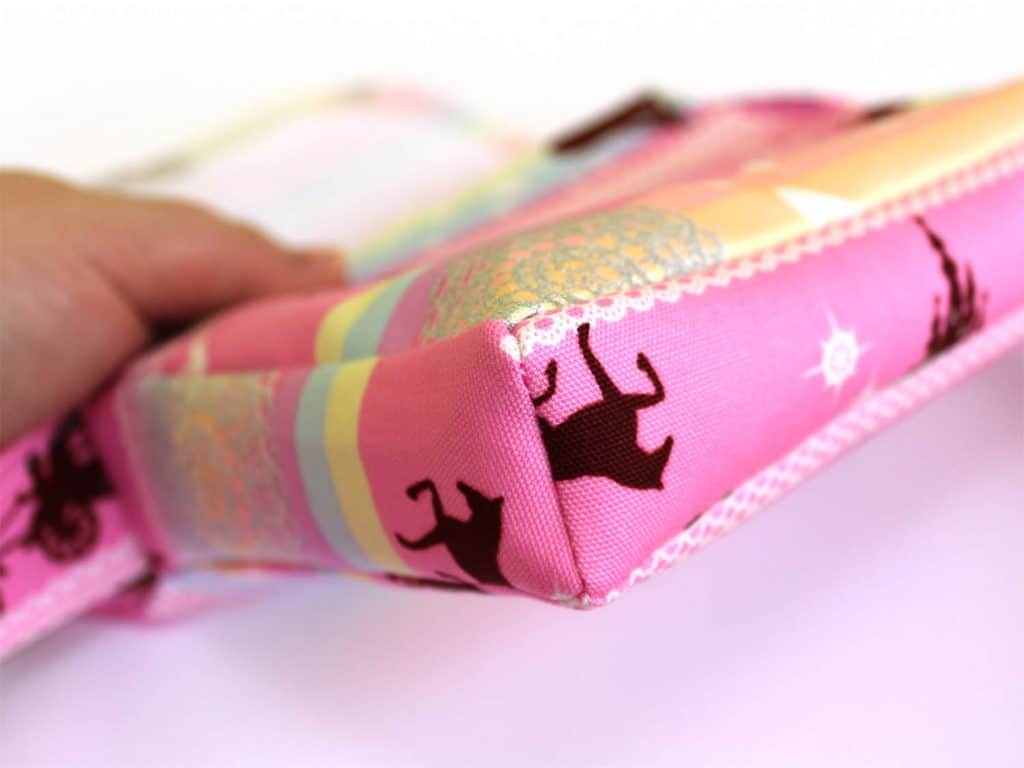
Step 24: Time to turn the exterior bag to the right side. Use a chopstick or turning tool to carefully push out the corners. The corners should look similar to the photo above. They aren’t ever going to be perfect square corners but if you sewed your seams and trimmed them correctly you should be able to get a nice finish.
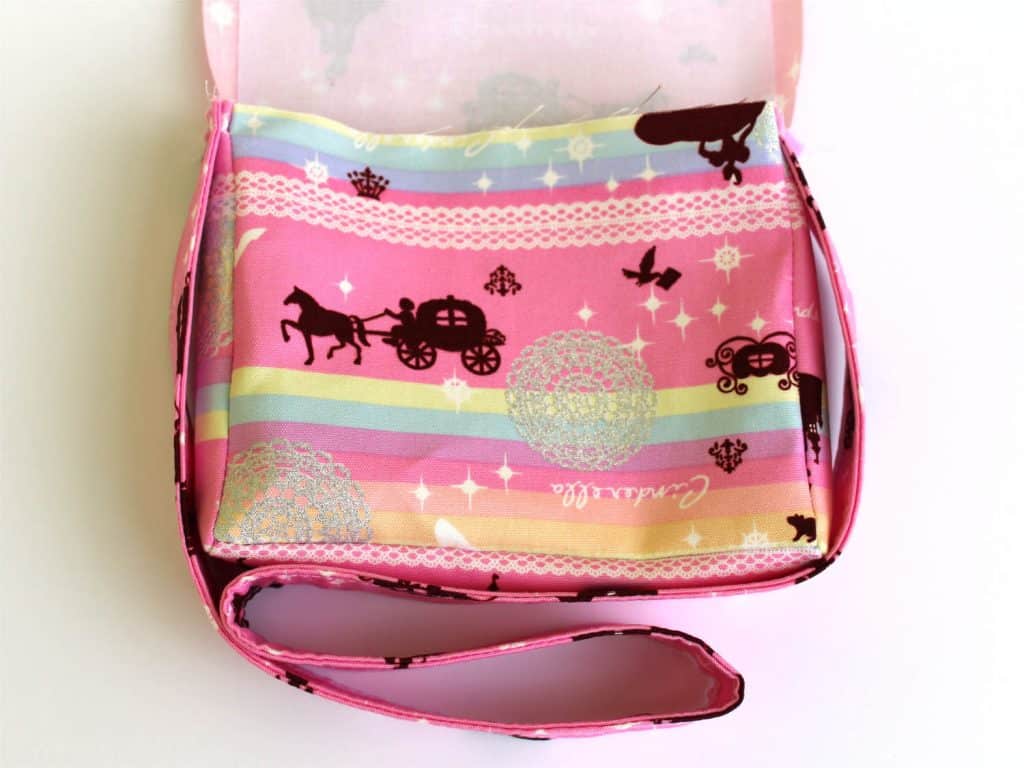
Step 25: Your messenger bag should look like the photo above. Double-check to make sure your strap is not twisted. If it is, correct it now. I like to fold my strap accordion style at the bottom of the bag in preparation for the next step.
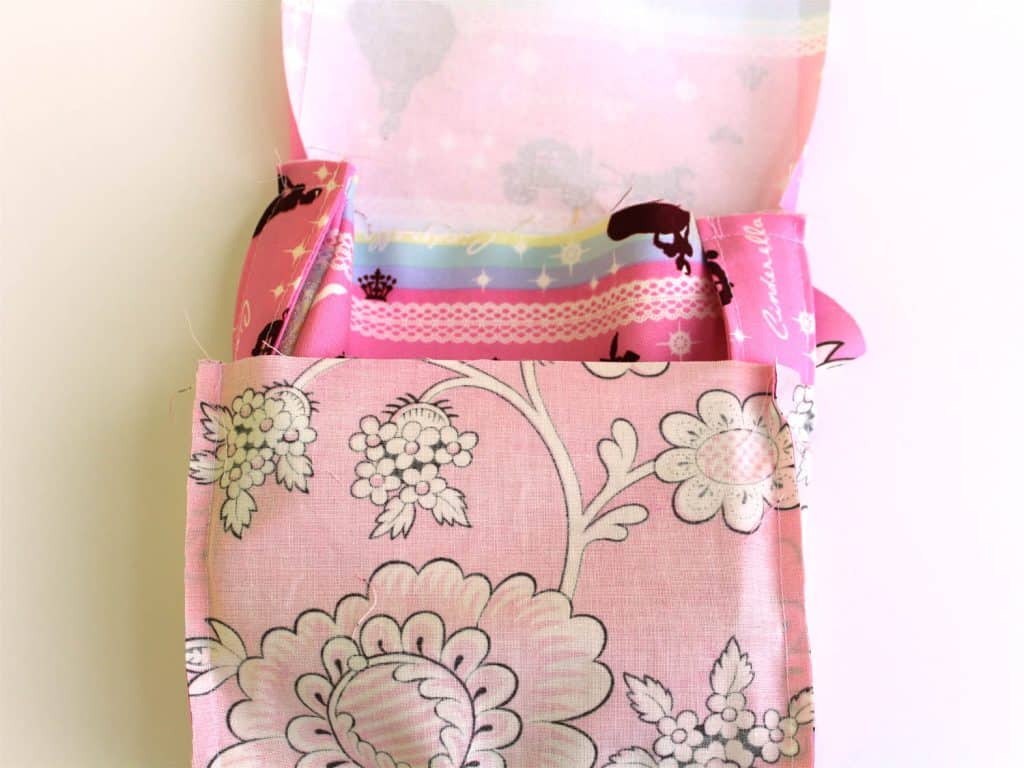
Step 26: We will now attach the lining to the exterior bag. Carefully slide the exterior bag into the lining bag (right sides will be together.) Keep the strap at the bottom and push it all the way in until the raw edges meet.
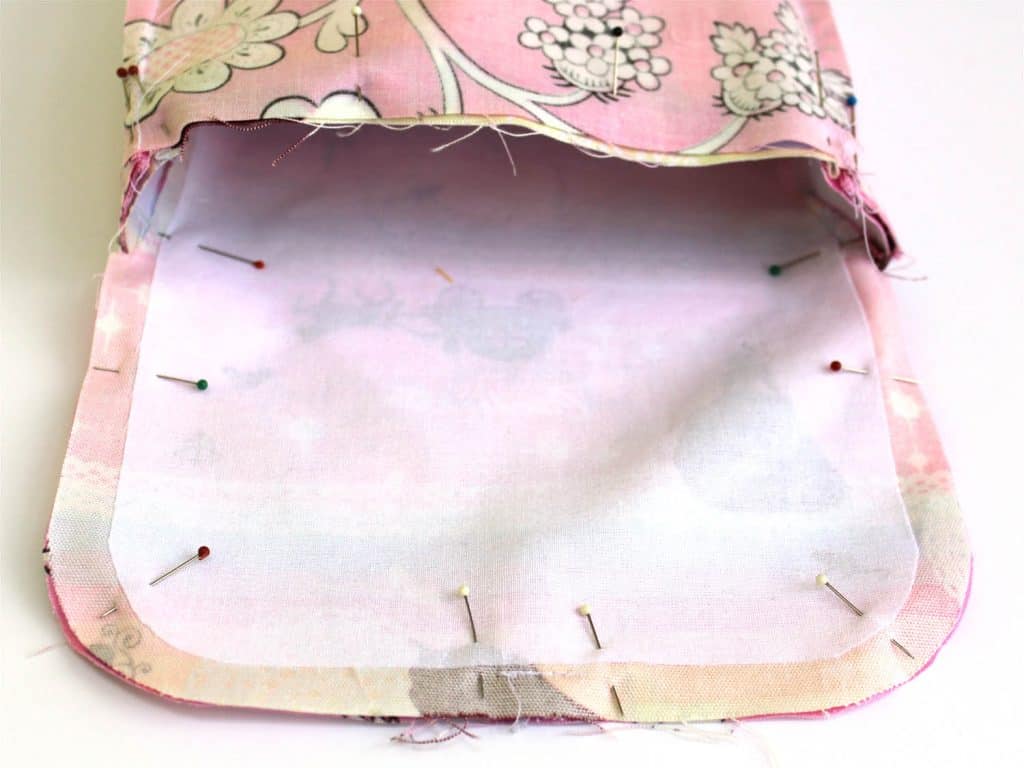
Step 27: Pin around the raw edges, all around the flap and the opening of the bag. Make sure the button closure is sandwiched in between the two layers and pin.
Starting with the flap, sew a 1/2″ seam, following along the interfacing. Stopping and starting when you meet up with the stitching of the bag body. You want to stitch the flap independent of the body. Make sure to back-stitch at both ends.
Step 28: Once the flap is sewn, then sew the sides and front edge of the body of the bag. This step sews in the strap and around the front piece to the other side with the strap. Sew a 1/2″ seam, back-stitching at both ends. Stop and start where the other stitching ends.
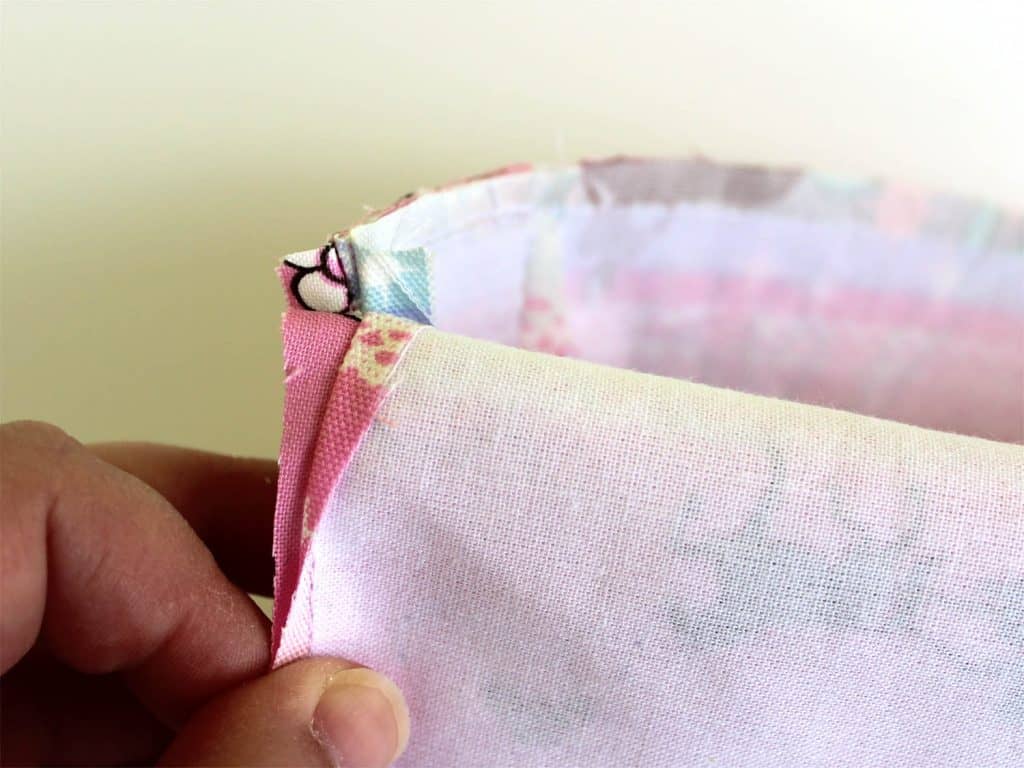
Step 29: Sewing those two seams independently makes it possible for the flap to move independently from the body of the bag. The photo above shows that the flap is folded back completely from the body of the messenger bag.
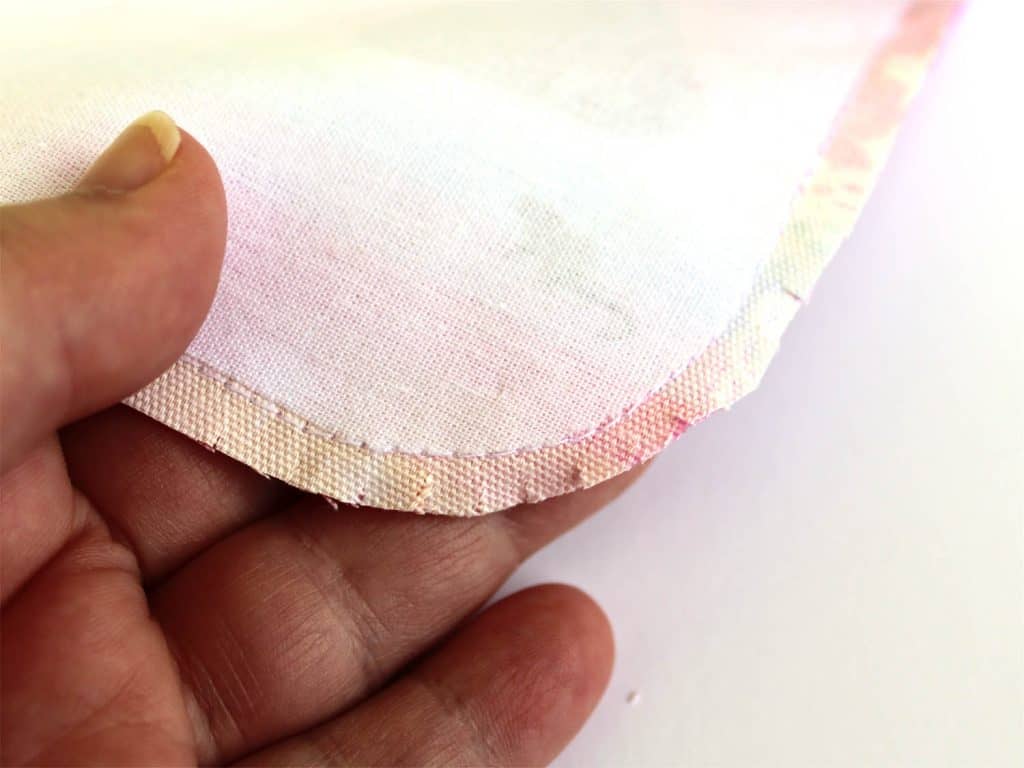
Step 30: Trim these two seams to 1/4″ and clip the rounded corners of the flap. I clip every 1/4″ around the rounded corners and close to the stitching but not through the stitching.
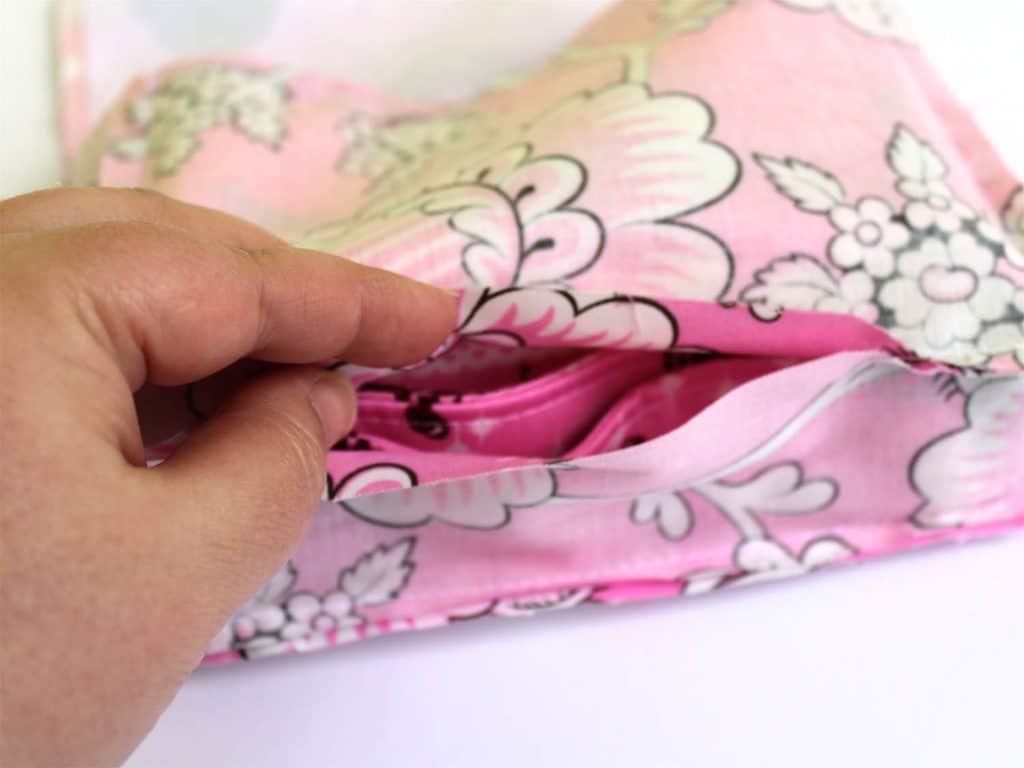
Step 31: Now that everything is trimmed it is time to turn the bag to the right side. Using that opening that you left in the bottom of the lining, put your hand in and grab the exterior bag, gently pulling it through the hole. Keep pulling until the entire bag is out and you are looking at the right side of the lining and the right side of the exterior.
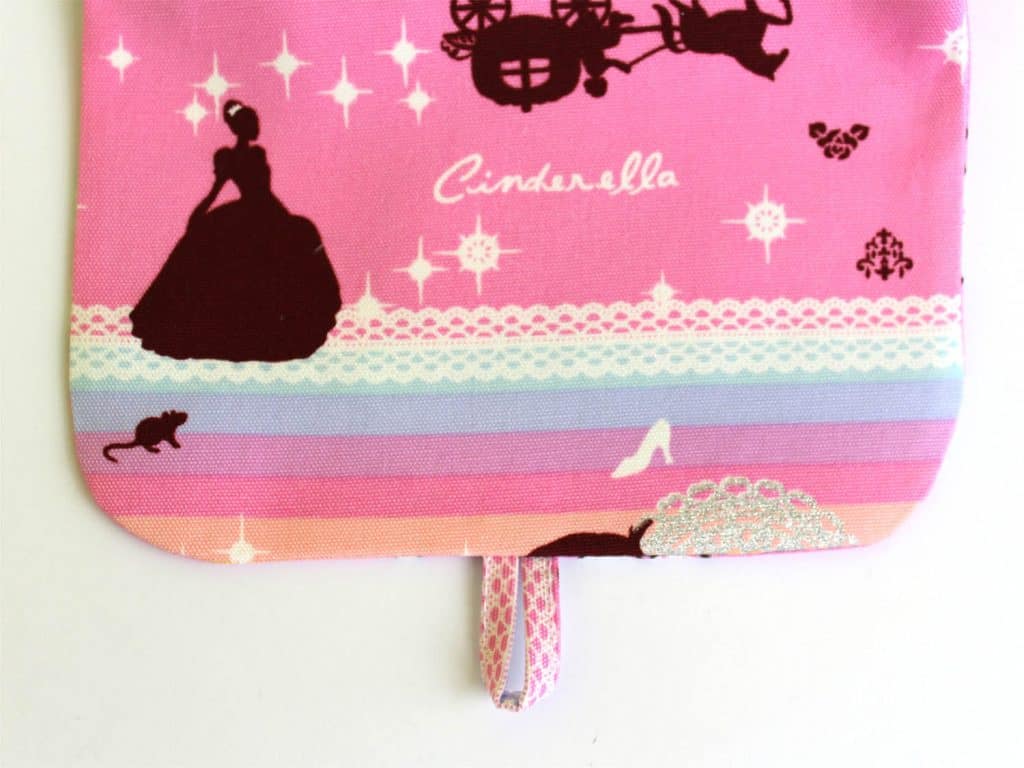
Step 32: Gently push out the rounded corners of the flap and press so that it is nice and flat. Sometimes it helps to use a chopstick and work from inside using the lining opening to work out those rounded corners.
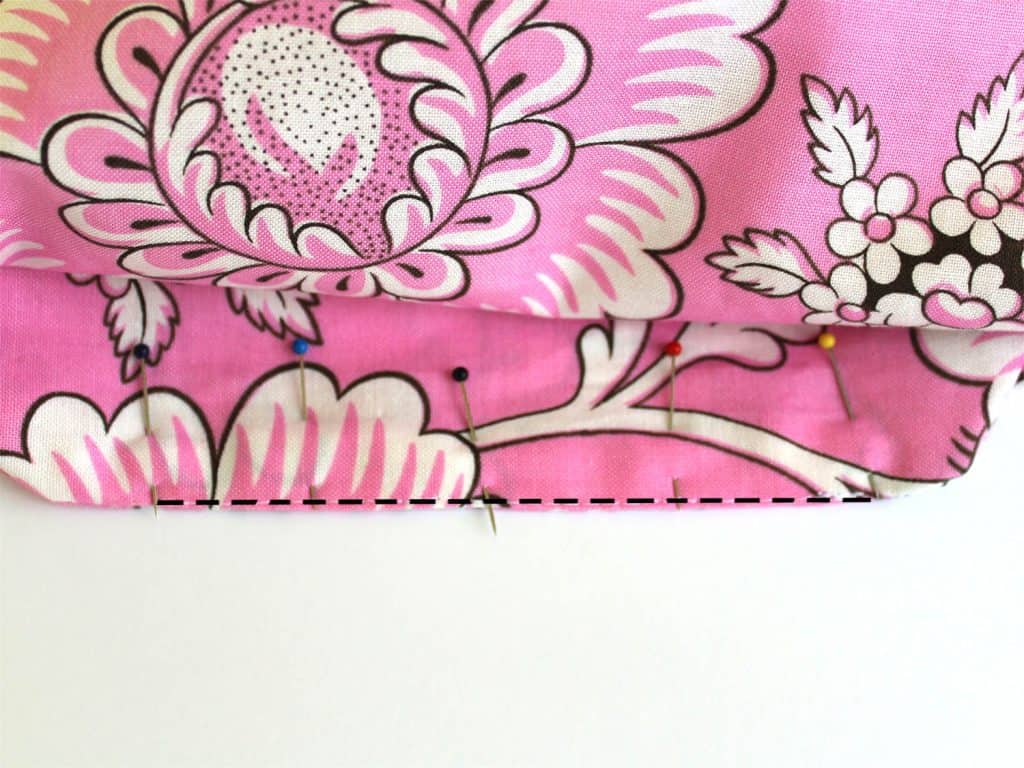
Step 33: Once your flap is nice and flat and ironed it is time to close up that lining hole. Turn in the raw edges 1/2″ and press. Pin the two edges, wrong sides together and stitch them closed, stitching as close to the edge as you can. Back-stitch at both ends.
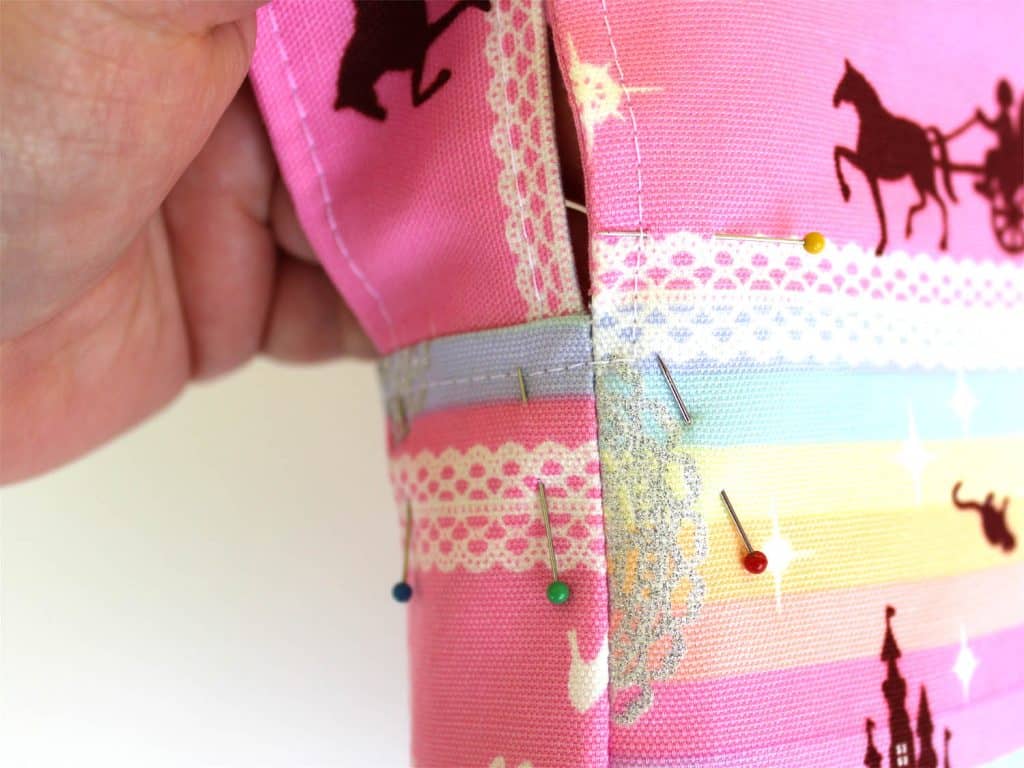
Step 34: Push the lining into the body of the messenger bag and line up everything nice and neat. Iron the top edge and pin the lining down. The photo above shows the bag side, strap and back/flap. Pin around the flap and the top edge and top stitch using a 3.0 stitch length. Stitch 1/4″ away from the edge and when you get to the side, stitch 1/4″ onto the flap, pivot and continue to stitch around the flap. Continue sewing until you meet up where you started top stitching.
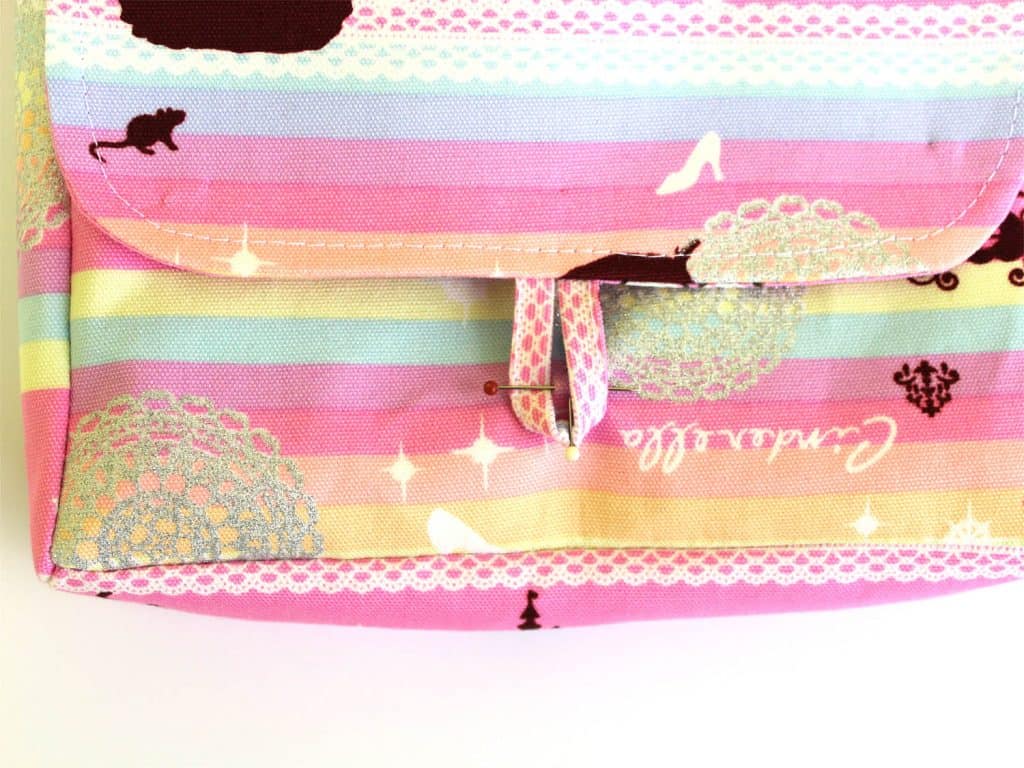
Step 35: We need to mark the button position (we are almost done!) Fold over the flap and using pins mark the center of the bag body and put another pin to mark where the button should be sewn on. I have two pins above in the shape of a cross, you can loop the button closure around these pins to see if you have the placement correct.
Hand sew on the button going through both the outer fabric and lining fabric. Doing this helps to keep the lining on the inside of the bag. Knot off your thread on the inside of the bag and cut your thread.
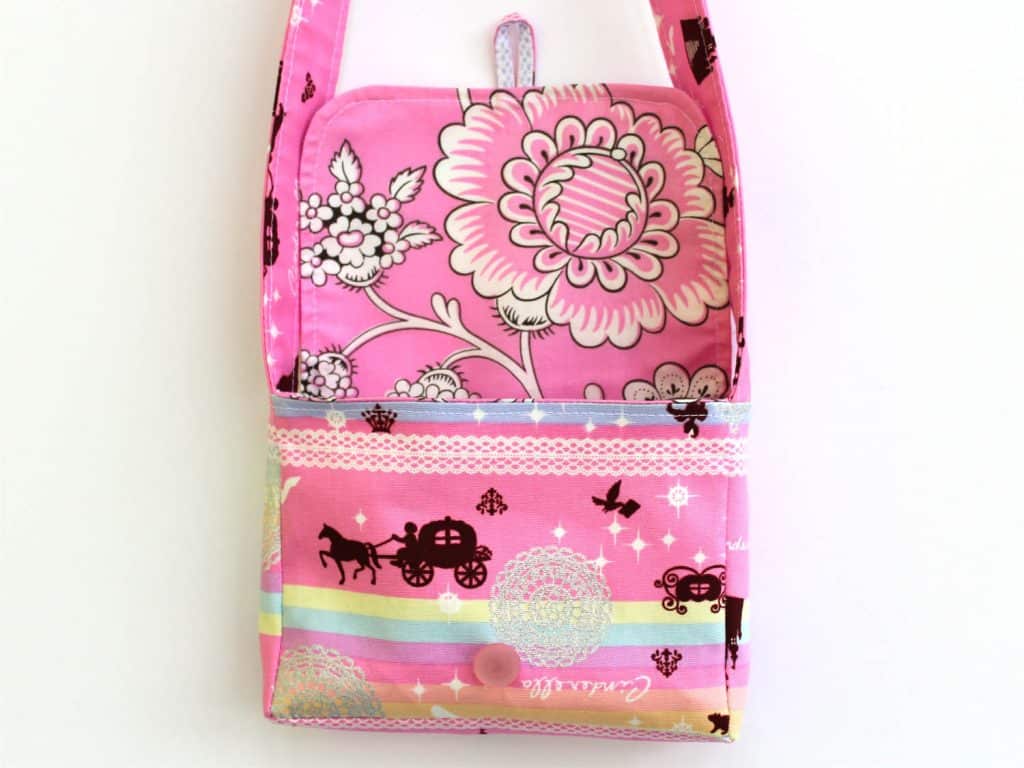
Can I repurpose old fabric or clothing to make my own messenger bag?
Yes, you can repurpose old fabric or clothing to make your own DIY messenger bag. It's a great way to upcycle and give new life to materials that you no longer use. Make sure the fabric is sturdy enough for a bag and follow a pattern or tutorial for guidance.
What Are Some Good Ways to Customize a Messenger Bag?
Customizing a messenger bag is a great way to add a personal touch and make a great bag. Go ahead an add side panels, an inner pocket, or an outer pocket to the sides of the bag. You can add pins, keychains, charms, and more. There are lots of possibilities - check Pinterest for some inspiration.
Conclusion
Congratulations you have a diy messenger bag! Sewing your own messenger bag can be a fun and rewarding simple project. By following the steps outlined in this blog, you can create a unique and personalized bag that suits your style and needs. Whether you're a beginner or an experienced sewist, making your own messenger bag allows you to unleash your creativity and showcase your sewing skills. So gather your materials, fire up your sewing machine, and get ready to craft a one-of-a-kind messenger bag that you'll be proud to carry around. Give it a final press and gift it to that child in your life, they will love it! If you enjoyed this tutorial you might also enjoy our Zipper Pouch Tutorial.
If you’d like further help with your sewing projects, come join our Peek-a-Boo Pattern Shop Facebook Group to get help with all of our PDF sewing patterns or follow us on Instagram. Happy sewing!
